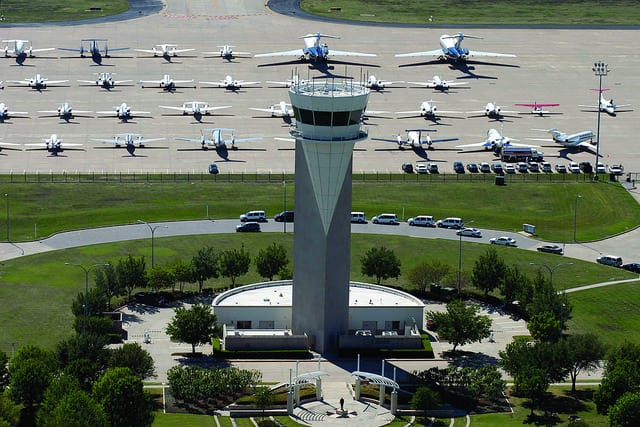
Photo courtesy of NATCA
The FAA’s goal of moving to a time-based air traffic system is challenged by the unpredictability of severe weather and the ability of air traffic controllers to introduce more automation into the way they manage the arrival of airplanes into the U.S. National Airspace System’s (NAS) busiest airports.
A panel of experts at the 2018 Air Traffic Controllers Association (ATCA) annual conference explained how the various segments of the U.S. air transportation system are still adjusting to the optimization of flight operations being introduced by NextGen technologies. NextGen, the FAA’s system of systems approach to modernizing the NAS, is rapidly transitioning from planning and deployment to initial testing and execution.
The agency, working with companies such as Leidos to introduce more automation into the way air traffic is managed, is challenged with addressing the impact of severe weather and air traffic controller adoption of more automation. There is also a need to establish and define a set of metrics that can provide actionable data showing how automation systems that have been deployed by the FAA are improving flight operational efficiency.
“We do good things on good weather days. But when you start getting challenges in convective thunderstorms, the variance between the good weather day and the bad weather day is how I would measure it,” said Joe Bertapelle, director of strategic airspace programs at JetBlue.
Bertapelle estimates that the New York City-based airline has invested more than $85 million retrofitting its aircraft with avionics capable of flying performance-based navigation routes, providing controller-to-pilot datalink communications (CPDLC) and complying with the FAA’s 2020 ADS-B Out mandate. But although JetBlue’s aircraft are technologically equipped for the NextGen airspace, transitioning to a time-based system involves the coordination of flight dispatchers, airport personnel, controllers and more.
Technologically speaking, the automation systems necessary to enable a time-based air traffic system are gradually being introduced. However, there is still some coordination needed, according to Judith Klein, a senior program advisor with Leidos who was also on the panel.
Leidos is providing the air traffic automation support for En Route Automation Modernization (ERAM), Advanced Technology Oceanic Procedures (ATOP), Time Based Flow Management (TBFM) and Terminal Flight Data Management (TFDM). Getting to the point where all of these systems share the same trajectory information between aircraft and ground automation systems that can get the NAS to a state of time-based air traffic is challenging because they’re all working off segregated data and information, said Klein.
“Each system builds or computes their own trajectories, and they don’t look exactly the same. If we each compute different trajectories and we don’t find a way to converge or at least use the same starting information across each system then its really, truly difficult to say to a pilot this is how you should fly, how high, the speed and so on,” said Klein.
Two of the NextGen systems Leidos is specifically focused on integrating are ERAM and TBFM. ERAM processes flight and surveillance data, provides communications and generates display data for controllers. The Lockheed Martin-developed system is designed to support satellite-based systems such as ADS-B and DataComm.
ERAM was implemented by the FAA at all 20 en-route ATC centers nationwide in 2015. The system enables en-route controllers at each center to track about 1,900 aircraft at a time — an 800-aircraft boost over the legacy host system. TBFM, in contrast, is a decision-support tool that will enable controllers to optimize spacing between aircraft and more accurately deliver aircraft to Terminal Radar Approach Control (TRACON).
TRACONs are used throughout the NAS to manage aircraft approaching or departing from airports. One of the challenges of integration, said Klein, is the human aspect of air traffic control.
“Controllers are communicating to the cockpit, and not taking the time to tell the automation that communication took place,” Klein said. “So the systems can’t make good decisions. … We can’t demand controllers be heads-down, on the computer, entering the data all the time, but we can try to automate that process and help them capture this information easier so that the systems have what they need and the users aren’t overloaded.”
The human side of air traffic control combined with the unpredictability and impact of severe weather still presents challenges to enabling a time-based air traffic system. As mentioned by Bertapelle, the NAS usually performs well on good weather days, making or beating their block times. The same cannot be said when weather is impacting significant areas of the system.
According to a 2016 study by The Weather Channel, San Francisco, Newark and Chicago are the most weather-delayed airports in the NAS. Although automation can’t change the weather, Bertapelle is hoping that it can at least provide airlines with the ability to give passengers earlier notice when a delay is going to occur.
Controllers themselves are also challenged in trying to keep up with the proliferation of automation being introduced, said Jeff Woods, a Project Management Organization (PMO) official for the National Air Traffic Controllers Association (NATCA).
Currently, controllers are trying to embrace more automated forms of time-based metering. This concept allows controllers to mange aircraft in congested airspace, such as the northeastern corridor of the NAS, more efficiently.
“Boston Center has one sector right now that has the ability to display five meter lists at one time, between New York, Boston and some of the other places, the way we do things today there’s no way a controller can manage five of those at one time,” said Woods.